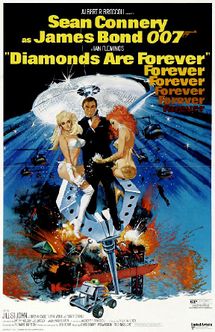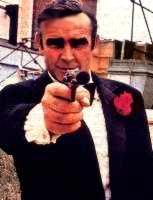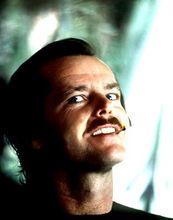Diamonds Are Forever
| Diamonds Are Forever | |

| |
| Directed by | Billy Wilder |
| Written by | Richard Burton |
| Starring | Sean Connery Jill St. John Jack Nicholson and Barry Nelson |
| Produced by | Albert R. Broccoli |
| Distributed by | United Artists |
| Release date | 1971 |
| Runtime | 153 min. |
| Language | English |
| Budget | $72,000,000 |
| Preceded by | On His Majesty's Secret Service (1969) |
| Succeeded by | Live and Let Die (1973) |
| IMDb page | |
Diamonds Are Forever is a 1971 film, the seventh in the James Bond film series. It was directed by Billy Wilder, produced by Albert R. Broccoli, and starred Sean Connery, Jill St. John, Jack Nicholson, and Barry Nelson.
Production[edit | edit source]
After the previous film, On His Majesty's Secret Service, was panned by critics, United Artists went back on its deal with George Lazenby and dropped him from his contract, giving his promised sequel to the established Bond, Sean Connery. After a worldwide search for the former 007, the producers found Connery on the streets of Edinburgh, drunk and homeless.
Once Connery was given his promised payment for cooperating on the film ($1,000,000 and a house in Beverly Hills), United Artists set about sorting together the rest of the cast and crew. Sacking the previous film's director, Jimmy Page, the producers turned to an old favourite: Billy Wilder, the director of Goldfinger. Now old and senile, Wilder was easily malleable to producer Albert R. Broccoli's wishes.
Because Broccoli did not want to work with Donald Pleasence, the portrayer of Ernst Stavro Blofeld, again, he decided to reuse some scrapped footage from You Only Live Twice to explain away Pleasence's absence. For this film's Blofeld, however, the producers nonsensically turned to former television actor Barry Nelson, who had played Bond ally Dikko Henderson in YOLT. For this, Nelson forced United Artists to cast his dimwitted wife, Jill St. John, in the pivotal role of Tiffany Case.
The final addition to the cast was up-and-coming actor Jack Nicholson, whom producer Broccoli gave $10,000 to portray gay assassin Burt Saxby.
After all this was done, however, the producers suddenly realized that they had no script to film. Hurriedly turning to the Actor's Guild, they were given drunken Irishman Richard Burton. Sticking him in a dark room with Ian Fleming's novel and a stack of papers, Burton turned out a script to United Artists within three weeks.
Story[edit | edit source]
Opening with 007 (Sean Connery) beating up an elderly Asian gentleman to learn the whereabouts of villain Ernst Stavro Blofeld, the film quickly montages through several violent assaults by Bond of people who know where SPECTRE's head is hiding.
Finally, he comes across a secret room, where he sees Blofeld (Donald Pleasence) pummelling MI6 operative Dikko Henderson (Barry Nelson) to the ground. Thinking fast, Bond takes his Walther PPK and blows the villain's brains out. Getting up, Henderson thanks 007 for rescuing him, and the two part ways outside. Meanwhile, Blofeld's cat stares up, hungrily.
(The preceding ten minutes of the film were taken from You Only Live Twice; the rest of the film is from DAF's shoot.)
Now over his obsession with SPECTRE, Bond is sent on a mission to Las Vegas to infiltrate the diamond business, due to the alarming trend of skyrocketing gem prices. Once there, he corners infamous diamond smuggler Bobby Franks, whom he quickly subdues. He then assumes Franks' identity, putting on a fake mustache, and goes up to meet the smuggler's contact, Tiffany Case (Jill St. John). Once at her apartment, he quickly learns she is working on the behalf of Vegas multibillionaire Howard Hughes Intrigued, Bond decides to bed down with her that night, only to find himself thrown out of bed by Burt Saxby, an assassin in the employ of Hughes. Taking Tiffany from 007's hotel room, Saxby kidnaps her and takes her to destinations unknown, leaving Bond alone in the dark.
007, angered by this unpleasant business, gets into his Ford Econoline and drives off in pursuit of Saxby, taking him through every corner of Las Vegas. Finally, he tracks the assassin to an old warehouse, where Bond confronts him and asks what he's done with Miss Case. Saxby, smiling, simply turns on a light switch, revealing Tiffany strapped to an assembly line as a table saw comes roaring up towards her muff.
The spy, having lived through Goldfinger and knowing exactly what to do in this sort of situation, convinces the assassin that he and Tiffany know nothing, only to throw him into a pile of wooden crates as soon as he's stopped the saw. Untying Miss Case, Bond takes her back to the car. When the two are gone, Saxby casually pulls himself out of the mass of splintered wood and brushes himself off.
Back at the hotel, 007 attempts to sort out the information coursing through his martini-fogged brain: Why would Hughes, a billionaire with no need of shining gems, be cornering the diamond market? Why would Hughes, a Vegas casino magnate, send an assassin after Bond, a man he's never even met? Most importantly, why is Bond himself not jumping that redhead's bones right now? Reinvigorated by this statement, the spy grabs Tiffany and leaps into bed, and the night air is soon filled with the sounds of sweet lovemaking.
The next morning, Bond and Miss Case visit the Howard Hughes Museum of Aeronautics, where they are set upon by two horribly random astronauts; 007 is beaten unconscious and Tiffany is dragged off. Once the spy reawakens, he is greeted by a most unwelcome sight: Dikko Henderson, lording over Bond and dressed in a duck-yellow Nehru jacket. When the spy dazedly asks what Henderson could be doing with Hughes, the other replies, in an all-too familiar voice, "You only live twice, Mr. Bond."
With a start, Bond realizes that the Blofeld he had seen before, the Blofeld pummelling Henderson to the ground, must have been a fake Blofeld -- the real Henderson, forcibly given plastic surgery to look like the villain -- meaning the Henderson he saved, the Henderson he allowed to get away --
Raging, 007 lunges at this false Henderson (whom he now realizes is Ernst Stavro Blofeld, the murderer of his wife, Tracy), but Blofeld sidesteps the howling spy, sending Bond flying into a steel cage. As the villain smiles coldly over the spy, Burt Saxby steps out from behind a pillar, holding a knife to the captive Tiffany Case's neck. With a lurid flourish, he drags his tongue over Tiffany's cheek, then slices her neck open with a flick of his knife.
As Case's body falls into a now-open pit of pirahnas, Bond howls in anguish, then miraculously bursts through the cage door, taking both Saxby and Blofeld by surprise. 007 runs up to the assassin and knees him in the solar plexus, sending Saxby screaming into the pirahna pit. With nowhere else to go, the villain Blofeld falls to his knees, begging for mercy, but the spy grabs him in a headlock. Crying for Bond not to kill him, the head of SPECTRE blubbers that he'll give 007 anything, anything at all if he lets him live.
- "Anything?" Bond asks.
- "Yes; anything, anything!"
"I want Tracy back, you son of a bitch!" 007 yells, and, with that, he rips out Blofeld's throat. As the villain flounders on the floor like a gutted fish, Bond picks up his gun and walks out. Bond then shows up at Hughes private penthouse and when the multibillionaire asks who the spy is, Bond replys "Bond, James Bond" before putting five hundred machine gun bullets into Hughes using a Tommy gun mounted on a tripod stand disguised as a camera for filming Hughes when he meets with his fellow crackwhore's.
Later on that night, the spy is sitting at the fountain in Caesar's Palace, thinking of everything that's happened to him, when a chunk of fountain blows up over his head. Startled, Bond looks around to find the source and sees Burt Saxby, battered but alive, leaning over a wall with a rifle and giving him the thumbs-up. Furiously yelling, 007 takes off in a running leap after Saxby and jumps over the wall, and the film ends with a freeze-frame in that moment.
Reaction[edit | edit source]
Box office was phenomenal, but Connery's agent refused to let the star participate in another Bond movie, owing to head trauma Connery had suffered during the shoot that had driven him loopy. Fortunately, the public would accept any Bond by then, as long as it wasn't George Lazenby.




